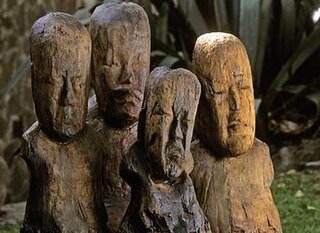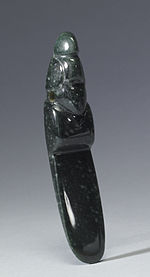
Jade is an umbrella term for two different types of decorative rocks used for jewelry or ornaments. Jade is often referred to by either of two different silicate mineral names: nephrite, or jadeite. Nephrite is typically green, although may be yellow, white or black. Jadeite varies from white or near-colorless, through various shades of green, to lavender, yellow, orange, brown and black. Rarely it may be blue. Both of these names refer to their use as gemstones, and each has a mineralogically more specific name. Both the amphibole jade (nephrite) and pyroxene jade are mineral aggregates (rocks) rather than mineral species. Nephrite was deprecated by the International Mineralogical Association as a mineral species name in 1978. The name "nephrite" is mineralogically correct for referring to the rock. Jadeite, is a legitimate mineral species, differing from the pyroxene jade rock. In China, the name jadeite has been replaced with fei cui, the traditional Chinese name for this gem that was in use long before Damour created the name in 1863.

Olmec figurines are archetypical figurines produced by the Formative Period inhabitants of Mesoamerica. While not all of these figurines were produced in the Olmec heartland, they bear the hallmarks and motifs of Olmec culture. While the extent of Olmec control over the areas beyond their heartland is not yet known, Formative Period figurines with Olmec motifs were widespread in the centuries from 1000 to 500 BCE, showing a consistency of style and subject throughout nearly all of Mesoamerica.

Jadeite is a pyroxene mineral with composition NaAlSi2O6. It is hard (Mohs hardness of about 6.5 to 7.0), very tough, and dense, with a specific gravity of about 3.4. It is found in a wide range of colors, but is most often found in shades of green or white. Jadeite is formed only in the subduction zones of continental margins, where rock undergoes metamorphism at high pressure but relatively low temperature.

Nephrite is a variety of the calcium, magnesium, and iron-rich amphibole minerals tremolite or actinolite (aggregates of which also make up one form of asbestos). The chemical formula for nephrite is Ca2(Mg, Fe)5Si8O22(OH)2. It is one of two different mineral species called jade. The other mineral species known as jade is jadeite, which is a variety of pyroxene. While nephrite jade possesses mainly grays and greens (and occasionally yellows, browns, black or whites), jadeite jade, which is rarer, can also contain blacks, reds, pinks and violets. Nephrite jade is an ornamental stone used in carvings, beads, or cabochon cut gemstones. Nephrite is also the official state mineral of Wyoming.

A metate is a type or variety of quern, a ground stone tool used for processing grain and seeds. In traditional Mesoamerican cultures, metates are typically used by women who would grind nixtamalized maize and other organic materials during food preparation. Similar artifacts have been found in other regions, such as the sil-batta in Bihar and Jharkhand, India as well as other grinding stones in China.

Jade use in Mesoamerica for symbolic and ideological ritual was highly influenced by its rarity and value among pre-Columbian Mesoamerican cultures, such as the Olmec, the Maya, and the various groups in the Valley of Mexico. Although jade artifacts have been created and prized by many Mesoamerican peoples, the Motagua River valley in Guatemala was previously thought to be the sole source of jadeite in the region.
Maya society concerns the social organization of the Pre-Hispanic Maya, its political structures, and social classes. The Maya people were indigenous to Mexico and Central America and the most dominant people groups of Central America up until the 6th century.

The long-legged bat is a member of the Phyllostomidae family in the order Chiroptera. Both males and females of this species are generally small, with wingspans reaching 80mm with an average weight ranging between 6 and 9 grams. The facial structure of these bats includes a shortened rostrum with a prominent noseleaf. The most defining feature of these bats however, is their long posterior limbs that extend farther than most Phyllostomidae bats. At the ends of these hind legs, the long-legged bat has abnormally large feet equipped with strong claws.

Tikal Temple I is the designation given to one of the major structures at Tikal, one of the largest cities and archaeological sites of the pre-Columbian Maya civilization in Mesoamerica. It is located in the Petén Basin region of northern Guatemala. It also is known as the Temple of the Great Jaguar because of a lintel that represents a king sitting upon a jaguar throne. An alternative name is the Temple of Ah Cacao, after the ruler buried in the temple. Temple I is a typically Petén-styled limestone stepped pyramid structure that is dated to approximately 732 AD.

Chinese jade refers to the jade mined or carved in China from the Neolithic onward. It is the primary hardstone of Chinese sculpture. Although deep and bright green jadeite is better known in Europe, for most of China's history, jade has come in a variety of colors and white "mutton-fat" nephrite was the most highly praised and prized. Native sources in Henan and along the Yangtze were exploited since prehistoric times and have largely been exhausted; most Chinese jade today is extracted from the northwestern province of Xinjiang.
Sierra de las Minas is a mountain range in eastern Guatemala which extends 130 km west of the Lake Izabal. It is 15–30 km wide and bordered by the valleys of the Polochic River in the north and the Motagua River in the south. Its western border is marked by the Salamá River valley which separates it from the Chuacús mountain range. The highest peak is Cerro Raxón at 3,015 m. The Sierras (Chuacús) rich deposits of jade and marble have been mined for centuries. The small scale mining activities explain the name of the mountain range.

El Manatí is an archaeological site located approximately 60 km south of Coatzacoalcos, in the municipality of Hidalgotitlán 27 kilometers southeast of Minatitlán in the Mexican state of Veracruz. El Manatí was the site of a sacred Olmec sacrificial bog from roughly 1600 BCE until 1200 BCE.

Greenstone is a common generic term for valuable, green-hued minerals and metamorphosed igneous rocks and stones which early cultures used in the fashioning of hardstone carvings such as jewelry, statuettes, ritual tools, and various other artifacts. Greenstone artifacts may be made of greenschist, chlorastrolite, serpentine, omphacite, chrysoprase, olivine, nephrite, chloromelanite among other green-hued minerals. The term also includes jade and jadeite, although these are perhaps more frequently identified by these latter terms. The greenish hue of these rocks generally derives from the presence of minerals such as chlorite, hornblende, or epidote.

Talgua Cave is a cave located in the Olancho Valley in the municipality of Catacamas in northeastern Honduras. The misnomer “The Cave of the Glowing Skulls” was given to the cave because of the way that light reflects off of the calcite deposits found on the skeletal remains found there. The site has gained the interest of archaeologists studying cave burials of Central America and of Mesoamerica as one of the most extensive Early to Middle Pre-Classic ossuary cave sites currently known to have been in contact with the Maya societies of nearby Mesoamerica. It provides many valuable clues to how the inhabitants of the Talgua Cave may have been an important link between Pre-Columbian Mesoamerica and parts further south and east in Central America and extending into those societies in northern South America, a region known as the Isthmo-Colombian Area.

Hardstone carving, in art history and archaeology, is the artistic carving of semi-precious stones, such as jade, rock crystal, agate, onyx, jasper, serpentinite, or carnelian, and for objects made in this way. Normally the objects are small, and the category overlaps with both jewellery and sculpture. Hardstone carving is sometimes referred to by the Italian term pietre dure; however, pietra dura is the common term used for stone inlay work, which causes some confusion.
Michael Jay Snarskis was an American archeologist who founded the scientific study of archaeology in Costa Rica. At that time, almost all artifacts available to collectors were shorn of their provenance and historical significance by huaquero looters, whom Snarskis described as "the tomb-robbers ... who have [made] such studies more difficult."

The use of mirrors in Mesoamerican culture was associated with the idea that they served as portals to a realm that could be seen but not interacted with. Mirrors in pre-Columbian Mesoamerica were fashioned from stone and served a number of uses, from the decorative to the divinatory. An ancient tradition among many Mesoamerican cultures was the practice of divination using the surface of a bowl of water as a mirror. At the time of the Spanish conquest this form of divination was still practiced among the Maya, Aztecs and Purépecha. In Mesoamerican art, mirrors are frequently associated with pools of liquid; this liquid was likely to have been water.

The extensive trade networks of the Ancient Maya contributed largely to the success of their civilization spanning three millennia. Maya royal control and the wide distribution of foreign and domestic commodities for both population sustenance and social affluence are hallmarks of the Maya visible throughout much of the iconography found in the archaeological record. In particular, moderately long-distance trade of foreign commodities from the Caribbean and Gulf Coasts provided the larger inland Maya cities with the resources they needed to sustain settled population levels in the several thousands. Though the ruling class essentially controlled the trade economy, a middle merchant class supervised import and export from cities and trade ports. Not much is known of the Maya merchant class; however, merchants of royal lineage are sometimes represented in the iconography. Notably, a canoe paddle often accompanies the royal merchant depictions, signifying their association with marine resources.

Pounamu is a term for several types of hard and durable stone found in the South Island of New Zealand. They are highly valued in New Zealand, and carvings made from pounamu play an important role in Māori culture.

Yupei is a generic term for jade pendants. Yupei were popular even before Confucius was born. Jade culture is an important component of Chinese culture, reflecting both the material and spiritual culture. Jade is deeply ingrained in Chinese culture and played a role in every aspect of social life; it is also associated with positive qualities and aspects such as purity, excellence, and harmony.Jade is even more valued than gold in Chinese culture. The history of the art of jade carving in China to make ornaments, including dress ornaments, extends back to before 5000 BC. Ancient Chinese held even greater importance to yupei after it was regarded as a moral integrity by Confucius. Yupei could be used as belt or waist ornaments and as necklaces which appeared as early as the Liangzhu culture. Strings of jade pendant are also used to decorate headwear, such as the mianguan.

















